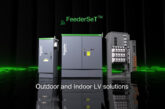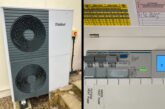
Paul Collins, Technical Support & Training Manager at Hager, gives an overview of the crucial role that surge protection technology plays.
Surge Protection Devices (SPDs) are used in electrical installation systems as protection devices. They’re designed to prevent excess voltage appearing at the terminals of sensitive equipment. Should an overvoltage event occur, the surge protection device diverts the resulting excess current flow to the earth and will protect the electrical appliance.
Any electronic equipment can be vulnerable to transient over-voltages, which can be caused by lightning activity or a switching event. This creates a voltage spike, increasing the wave’s magnitude to potentially several thousand volts. This could cause instant damage or significantly reduce a piece of equipment’s lifespan.
The need for surge protection devices can depend on numerous factors. These can include the exposure of a building to lightning induced voltage transients, the sensitivity and value of the equipment, the type of equipment used within the installation and whether there is equipment within the installation that could generate voltage transients.
Different types of surge protection
Based on the type of application, different types of surge protection devices are used. Type 1 surge protection devices are used in conjunction with a lightning protection system. They do not in themselves offer effective protection against the failure of sensitive equipment, so to afford this protection they will need to be used and co-ordinated with one or more Type 2 devices. These Type 2 devices will usually be installed in distribution boards. Type 3 devices, which are only required to be installed as a supplement to Type 2, have a low discharge capacity and, as such, are installed if required near the equipment to be protected.
When installing surge protection devices you should, of course, refer to BS 7671.

Getting the right connection
Making sure a connection is correct is vital when using surge protection devices. To obtain the maximum protection from the SPD, the connecting conductors should be kept as short as possible. This is in order to minimise any additive voltages from the connecting cables, and ideally should not exceed 0.5m
The cross-sectional area of connecting conductors is also an important consideration. A Type 1 SPD shall have a cross sectional area of not less than 16mm² and, for Type 2, the conductor size should not be less than 4mm² copper.
SURGE PROTECTION: A GROWING MARKET
More commercial projects than ever before are now actively considering ways they can protect valuable electrical equipment from power surges, which can crash hard drives and modems and also ruin appliances. In fact, the Global Surge Protection Devices Market report is forecasting devices to grow at 5.83% CAGR globally over the next five years.
It’s also important to remember, when carrying out an insulation resistance test at the common value of 500V dc with a surge protection device connected you will likely get incorrect readings. This is because the SPD will start to conduct at this value of voltage. The SPD will be required to be disconnected before carrying out this test. Alternatively, the test voltage value can be reduced to 250V dc.
At Hager, we offer a range of surge protection devices to help make the equipment within your next installation even safer.








